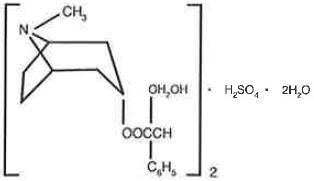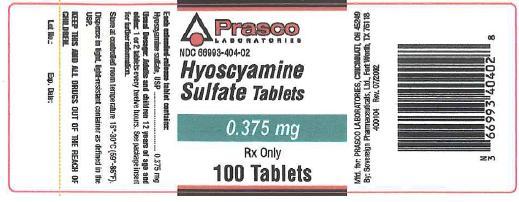HYOSCYAMINE SULFATE
-
hyoscyamine sulfate tablet
Prasco Laboratories
----------
HYOSCYAMINESULFATE
0.375 MG
TABLETS
11 DESCRIPTION
Each Extended-release tablet contains:
Hyoscyamine Sulfate . . . . . . 0.375 mg
Inactive ingredients: calcium phosphate, ethylcellulose, lactose monohydrate, magnesium stearate, microcrystalline cellulose, stearic acid.
Hyoscyamine sulfate is one of the principal anticholinergic/antispasmodic components of belladonna alkaloids. The empirical formula is (C17H23NO3)2•H2SO4•2H2O and the molecular weight is 712.85. Chemically, it is benzeneacetic acid, α-(hydroxymethyl)-, 8-methyl-8-azabicyclo [3.2.1] oct-3-yl ester, [3(S)-endo]-,sulfate (2:1), dihydrate.
Hyoscyamine Sulfate:

Hyoscyamine Sulfate Sustained-Release Tablets contain 0.375 mg of hyoscyamine sulfate in a formulation designed for oral b.i.d. dosage.
12 CLINICAL PHARMACOLOGY
Hyoscyamine sulfate inhibits specifically the actions of acetylcholine on structures innervated by postganglionic cholinergic nerves and on smooth muscles that respond to acetylcholine but lack cholinergic innervation. These peripheral cholinergic receptors are present in the autonomic effector cells of the smooth muscle, cardiac muscle, the sinoatrial node, the atrioventricular node, and the exocrine glands. At therapeutic doses, it is completely devoid of any action in the autonomic ganglia. Hyoscyamine sulfate inhibits gastrointestinal propulsive motility and decreases gastric acid secretion. Hyoscyamine sulfate also controls excessive pharyngeal, tracheal and bronchial secretions.
Hyoscyamine sulfate is absorbed totally and completely by sublingual administration as well as oral administration. Once absorbed, Hyoscyamine sulfate disappears rapidly from the blood and is distributed throughout the entire body. The half-life of Hyoscyamine sulfate is 2 to 3 1/2 hours. Hyoscyamine sulfate is partly hydrolyzed to tropic acid and tropine but the majority of the drug is excreted in the urine unchanged within the first 12 hours. Only traces of this drug are found in breast milk. Hyoscyamine sulfate passes the blood brain barrier and the placental barrier. Hyoscyamine sulfate releases 0.375 mg hyoscyamine sulfate at a controlled and predictable rate for 12 hours. Peak blood levels occur in approximately 4 hours and the apparent plasma elimination half-life is approximately 9 hours. The relative bioavailability of the sustained- release tablet is approximately 92% that of the immediate release tablet. Tablets may not completely disintegrate and may be excreted by some patients.
1 INDICATIONS & USAGE
Hyoscyamine sulfate is effective as adjunctive therapy in the treatment of peptic ulcer. It can also be used to control gastric secretion, visceral spasm, and hypermotility in spastic colitis, spastic bladder, cystitis, pylorospasm, and associated abdominal cramps. May be used in functional intestinal disorders to reduce symptoms such as those seen in mild dysenteries, diverticulitis, and acute enterocolitis. For use as adjunctive therapy in the treatment of irritable bowel syndrome (irritable colon, spastic colon, mucous colitis) and functional gastrointestinal disorders. Also used as adjunctive therapy in the treatment of neurogenic bladder and neurogenic bowel disturbances (including the splenic flexure syndrome and neurogenic colon). Hyoscyamine sulfate is indicated along with morphine or other narcotics in symptomatic relief of biliary and renal colic; as a “drying agent” in the relief of symptoms of acute rhinitis; in the therapy of parkinsonism to reduce rigidity and tremors and to control associated sialorrhea and hyperhidrosis. May be used in the therapy of poisoning by anticholinesterase agents.
Hyoscyamine sulfate may be used to reduce pain and hypersecretion in pancreatitis.
Hyoscyamine sulfate may also be used in certain cases of partial heart block associated with vagal activity.
4 CONTRAINDICATIONS
Glaucoma; obstructive uropathy (for example, bladder neck obstruction due to prostatic hypertrophy); obstructive disease of the gastrointestinal tract (as in achalasia, pyloroduodenal stenosis); paralytic ileus, intestinal atony of elderly or debilitated patients; unstable cardiovascular status in acute hemorrhage; severe ulcerative colitis; toxic megacolon complicating ulcerative colitis; myasthenia gravis.
WARNINGS
In the presence of high environmental temperature, heat prostration can occur with drug use (fever and heat stroke due to decreased sweating). Diarrhea may be an early symptom of incomplete intestinal obstruction, especially in patients with ileostomy or colostomy. In this instance, treatment with this drug would be inappropriate and possibly harmful. Like other anticholinergic agents, Hyoscyamine sulfate may produce drowsiness, dizziness or blurred vision. In this event, the patient should be warned not to engage in activities requiring mental alertness such as operating a motor vehicle or other machinery or to perform hazardous work while taking this drug.
Psychosis has been reported in sensitive individuals given anticholinergic drugs. CNS signs and symptoms include confusion, disorientation, short term memory loss, hallucinations, dysarthria, ataxia, coma, euphoria, decreased anxiety, fatigue, insomnia, agitation and mannerisms, and inappropriate affect. These CNS signs and symptoms usually resolve within 12-48 hours after discontinuation of the drug.
PRECAUTIONS
General:
Use with caution in patients with: autonomic neuropathy, hyperthyroidism, coronary heart disease, congestive heart failure, cardiac arrhythmias, hypertension and renal disease. Investigate any tachycardia before giving any anticholinergic drug since they may increase the heart rate. Use with caution in patients with hiatal hernia associated with reflux esophagitis.
17 INFORMATION FOR PATIENTS
Like other anticholinergic agents, Hyoscyamine sulfate may produce drowsiness, dizziness or blurred vision. In this event, the patient should be warned not to engage in activities requiring mental alertness such as operating a motor vehicle or other machinery or to perform hazardous work while taking this drug.
Use of Hyoscyamine sulfate may decrease sweating resulting in heat prostration, fever or heat stroke; febrile patients or those who may be exposed to elevated environmental temperatures should use caution. Tablets may not completely disintegrate and may be excreted by some patients.
7 DRUG INTERACTIONS
Additive adverse effects resulting from cholinergic blockade may occur when Hyoscyamine sulfate is administered concomitantly with other antimuscarinics, amantadine, haloperidol, phenothiazines, monoamine oxidase (MAO) inhibitors, tricyclic antidepressants or some antihistamines. Antacids may interfere with the absorption of Hyoscyamine sulfate; take Hyoscyamine sulfate before meals and antacids after meals.
1 CARCINOGENESIS & MUTAGENESIS & IMPAIRMENT OF FERTILITY
No long term studies in animals have been performed to determine the carcinogenic, mutagenic or impairment of fertility potential of Hyoscyamine sulfate; however, 40 years of marketing experience shows no demonstrable evidence of a problem.
Pregnancy-Pregnancy category C:
Animal reproduction studies have not been conducted with Hyoscyamine sulfate. It is also not known whether Hyoscyamine sulfate can cause fetal harm when administered to a pregnant woman or can affect reproduction capacity. Hyoscyamine sulfate should be given to a pregnant woman only if clearly needed.
3 NURSING MOTHERS
Hyoscyamine sulfate is excreted in human milk. Caution should be exercised when Hyoscyamine sulfate is administered to a nursing woman.
4 PEDIATRIC USE
This product is not recommended for use in children under two years of age. Infants and young children are especially susceptible to the toxic effects of anticholinergics. Close supervision is recommended for infants and children with spastic paralysis or brain damage since an increased response to anticholinergics has been reported in these patients and dosage adjustments are often required. When anticholinergics are given to children where the environmental temperature is high, there is a risk of a rapid increase in body temperature because of these medications’ suppression of sweat gland activity. A paradoxical reaction characterized by hyperexcitability may occur in children taking large doses of anticholinergics.
5 GERIATRIC USE
Geriatric patients may respond to usual doses of anticholinergics with excitement, agitation, drowsiness, or confusion. Geriatric patients are especially susceptible to the anticholinergic side effects, such as constipation, dryness of mouth, and urinary retention (especially in males). If these side effects occur and continue or are severe, medication should probably be discontinued.
Caution is also recommended when anticholinergics are given to geriatric patients, because of the danger of precipitating undiagnosed glaucoma. Memory may become severely impaired in geriatric patients, especially those who already have memory problems, with the continued use of anticholinergics since these drugs block the actions of acetylcholine, which is responsible for many functions of the brain, including memory functions.
6 ADVERSE REACTIONS
Not all of the following adverse reactions have been reported with hyoscyamine sulfate. The following adverse reactions have been reported for pharmacologically similar drugs with anticholinergic/antispasmodic action. Adverse reactions may include dryness of mouth; urinary hesitancy and retention; blurred vision; tachycardia; palpitations; mydriasis; cycloplegia; increased ocular tension; loss of taste; headache; nervousness; drowsiness; weakness; dizziness; insomnia; nausea; vomiting; impotence; suppression of lactation; constipation; bloated feeling; allergic reactions or drug idiosyncrasies; urticaria and other dermal manifestations; ataxia; speech disturbance; some degree of mental confusion and/or excitement (especially in elderly persons); and decreased sweating.
10 OVERDOSAGE
The signs and symptoms of overdosage are headache, nausea, vomiting, blurred vision, dilated pupils, hot dry skin, dizziness, dryness of mouth, difficulty in swallowing and CNS stimulation. Measures to be taken are immediate lavage of the stomach and injection of physostigmine 0.5 to 2 mg intravenously and repeated as necessary up to a total of 5 mg. Fever may be treated symptomatically (tepid water sponge baths, hypothermic blanket). Excitement to a degree which demands attention may be managed with sodium thiopental 2% solution given slowly intravenously or chloral hydrate (100-200 mL of a 2% solution) by rectal infusion. In the event of progression of the curare-like effect to paralysis of the respiratory muscles, artificial respiration should be instituted and maintained until effective respiratory action returns. In rats, the LD5 0 for Hyoscyamine sulfate is 375 mg/kg. Hyoscyamine sulfate is dialyzable.
2 DOSAGE & ADMINISTRATION
Dosage may be adjusted according to the conditions and severity of symptoms.
Hyoscyamine Sulfate Extended-Release Tablets:
Adults and pediatric patients 12 years of age and older: 1 to 2 tablets every 12 hours. Tablets are scored and may be broken to allow for dose titration if needed. Do not crush or chew tablets. Do not exceed 4 tablets in 24 hours.
16 HOW SUPPLIED
Supplied as white, capsule shaped tablets, scored and debossed “404” on top, Prasco Laboratories logo on bottom. Bottles of 100 tablets, NDC 66993-404-02.
KEEP THIS AND ALL MEDICATION OUT OF THE REACH OF CHILDREN. IN CASE OF ACCIDENTAL OVERDOSE, SEEK PROFESSIONAL ASSISTANCE OR CONTACT A POISON CONTROL CENTER IMMEDIATELY.
Dispense in tight, light-resistant containers as defined in the USP-NF.
Store at controlled room temperature 59° - 86°F (15°- 30°C).
Manufactured for:
PRASCO LABORATORIES
Cincinnati, OH 45249
by:
Sovereign Pharmaceuticals, Ltd.
Fort Worth, TX 76118
PIPRAS-02
Iss. 3/2002
PACKAGE LABEL.PRINCIPAL DISPLAY PANEL

| HYOSCYAMINE SULFATE
hyoscyamine sulfate tablet |
||||||||||||||||||
|
||||||||||||||||||
|
||||||||||||||||||
|
||||||||||||||||||
|
||||||||||||||||||
|
||||||||||||||||||
| Marketing Information | |||
| Marketing Category | Application Number or Monograph Citation | Marketing Start Date | Marketing End Date |
| Unapproved drug other | 05/01/2002 | 09/30/2009 | |
| Labeler - Prasco Laboratories (065969375) |
| Establishment | |||
| Name | Address | ID/FEI | Operations |
| Sovereign Pharmaceuticals, Ltd. | 623168267 | MANUFACTURE | |